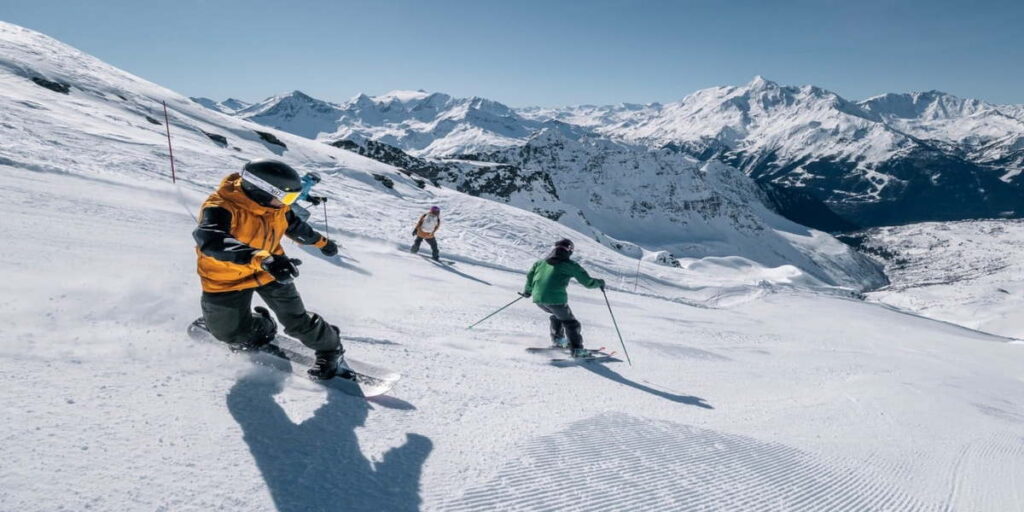✅ Last Update: Apr 26, 2025 @ 10:36 am
New Zealand is famous for its stunning views and outdoor fun—and yes, that includes skiing too! Whether you’re an experienced skier or trying it for the first time, the country has something for everyone, specially if you are planning to travel in winter.
- In this easy guide, we’ll take you through the top ski spots on both the North and South Islands, share helpful tips, and give you a feel for what it’s really like to hit the slopes in Aotearoa. Let’s check out what the New Zealand ski season has for everyone!
1. The Allure of New Zealand Skiing
The mountains here are wide, open, and often treeless, with rocky views that give the whole place a wild, adventurous vibe.
The ski season usually starts in June and can go all the way to November, depending on the snow. During these months, parts of New Zealand turn into a winter playground—drawing skiers and snowboarders from all over the world.

2. North Island Ski Fields
The North Island has some great spots for skiing, with something for everyone—whether you’re just starting out or already carving up the slopes.
- On Mt Taranaki, Manganui is a small, friendly ski field run by volunteers. It’s perfect if you want a real adventure—you can even surf and ski on the same day!
- On Mt Ruapehu, you’ll find Whakapapa and Turoa, two of the biggest ski areas in the country. Each one has its own special vibe and plenty of space to explore.
Tukino, also on Mt Ruapehu, is a smaller, relaxed field that’s great for beginners and experienced skiers who want a quieter day on the snow.
📌 If you’re in Auckland and don’t want to travel far, check out Snowplanet—New Zealand’s only indoor ski slope. It’s a fun and easy way to practice your skills all year round.

3. South Island Ski Fields
The South Island is a dream come true for ski lovers. It’s full of amazing ski fields and great hikes for winter.
- Just outside of Methven, Mt Hutt has nearly 500 hectares of space to explore. With great snow and modern facilities, it’s a favourite for people coming from Christchurch.
- Near Queenstown, Coronet Peak is famous for night skiing and big international ski events. It’s easy to reach and always buzzing with energy.
- Also close to Queenstown, The Remarkables is a fun spot for all levels. You’ll find everything from beginner slopes to a half-pipe and even a tubing park if you want something different.
- Between Queenstown and Wānaka, Cardrona is the biggest ski field in the area. It’s great for families, beginners, and intermediate riders looking for long, gentle runs.
🥇 For more of a challenge, head to Treble Cone, the largest ski area on the South Island. It’s perfect for intermediate and advanced skiers who want wide-open terrain and amazing views over Lake Wānaka.

4. Club Fields and Hidden Gems
If you’re after a more relaxed and local ski experience, the South Island has a bunch of club fields—each with its own unique charm.
Places like Rainbow, Temple Basin, Craigieburn, Broken River, Cheeseman, Mt Olympus, Fox Peak, and Hanmer Springs offer smaller slopes with tow-ropes or T-bars instead of fancy lifts.
- The facilities might be basic, but the vibe is awesome—super friendly, social, and a bit adventurous.
✅ If you want to explore a few of these hidden gems, the Chill Pass is a great option. It gives you access to lots of these club fields and is perfect for skiers and boarders who love getting off the beaten track.

📝 Staying Informed with Handy Websites
To keep up with snow reports, events, and everything happening on the slopes, there are a couple of super handy websites you’ll want to bookmark.
- SnowNZ is a go-to site for ski info across the country. They post a detailed update every Thursday afternoon, so you can plan your weekend trip with confidence.
- NZSki runs Coronet Peak, The Remarkables, and Mt Hutt, and they offer passes that work across all three fields. If you’re planning ahead, keep an eye out for their early bird season passes—they usually go on sale in October and can save you a lot.
🧑💻 FAQs about The New Zealand Ski Season
You can bring your own gear, but if you’re travelling light, rentals are available at all major ski fields. You can rent skis, snowboards, boots, jackets, and even helmets.
It can be, but there are ways to save! Look for early bird passes, multi-day deals, and Chill Passes for club fields. Staying in smaller towns instead of resort areas can also help your budget.
Absolutely! Fields like Cardrona, The Remarkables, and Mt Hutt have great beginner areas with lessons and easy slopes to get you started.
Yes—always carry snow chains in winter. Some roads to ski fields are steep and icy, and chains are often required for safety.








